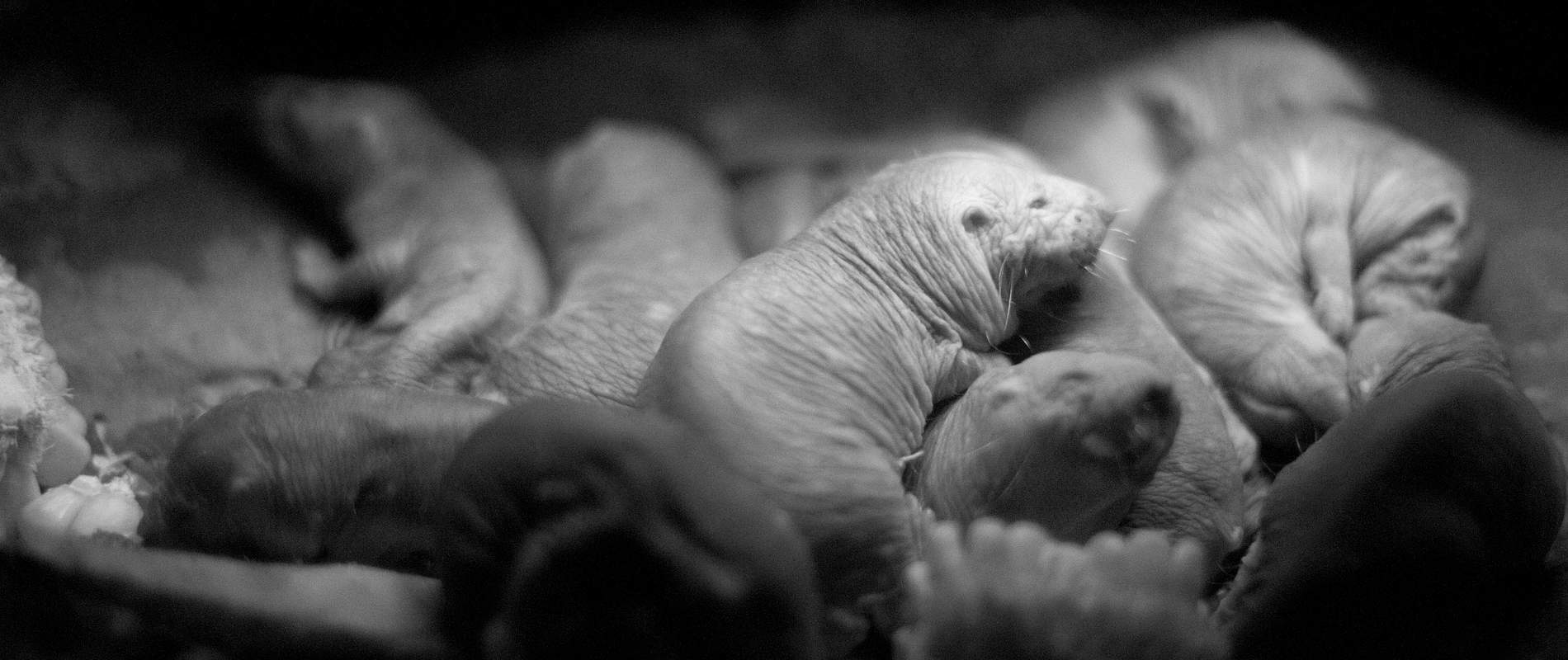Imagine living under ground for 20 years, travelling through tunnels carved out with your teeth, feeding on tubers and faeces.
This may not seem like the most appealing life, but it takes unique animals to thrive in unique environments.
As far as eight feet below the surface and thus insulated from the harsh sun in the semi-arid environment they call home, naked mole-rats live in an expansive network of tunnels and chambers for almost the entire duration of their life. Perhaps because their environment's temperature is relatively constant, their own temperature conforms to ambient conditions rather than being self-regulated like other mammals. As a result, they modify their behaviour, much like reptiles, to adjust to extreme temperatures. When cold, they huddle together in shallower tunnels closer to the warm surface and when hot seek refuge in deeper, cooler tunnels below. Naked mole-rats have also adapted in other interesting ways.

They are the longest-lived rodent in the world (the longest recorded life being 32 years), and according to research - highly resistant to cancer. Their cells secrete a kind of sugar, which prevents cancerous cells from multiplying and overcrowding. Their longevity (relative to similar sized rodents) is attributable to to a special protein that removes incorrectly manufactured or damaged proteins from cells before they build up. As a result, naked mole rats also retain youthfulness until much later in life.

Another interesting adaptation of naked mole rats allows them to tolerate high levels of CO2. This comes in handy in underground chambers where large numbers of mole-rats may live in close quarters. As CO2 builds up in the body, it is converted into an acid, which activates pain receptors. Unlike most animals, naked mole-rats have lost the ability to transmit this signal. In fact, they are completely insensitive to pain caused by acids, not even reacting when injected with capsicum.

The social strata of naked mole rats is structured around a reproductive queen. Her dominance over other females in the colony influences their ability, or rather inability to reproduce. It is thought that the stress of being dominated by the queen suppresses the production of certain hormones preventing their ovaries from fully maturing. One or two reproducing males will mate with the queen and the rest of the non-reproducing colony is responsible for digging tunnels, finding food and caring for the queen's pups who are weened off of the queen's milk with their caretakers' faeces. Larger workers protect the tunnels while smaller workers do the majority of the work.

Digging tunnels is actually a group effort carried out assembly-line style with designated roles. One worker digs, while others sweep earth and sand out of the way. Finally, the last in line flings piles of dirt out of an exit to form volcanic-shaped cones on the surface. In Tsavo, especially after rain, these cones are commonly found along ochre roads and animal tracks. They are shy creatures and difficult to catch a proper glimpse of without trapping them, but a short, quiet wait over an active hole will usually be rewarded with the sight of a pair nostrils and eyes peering back at you.


The naked mole-rats of Tsavo were the first well studied wild population of this species. After a South African researcher, Jennifer Jarvis, described them as eusocial, with a queen and sterile workers like bees, another scientist, Rob Brett, spend a number of years in the 1980s studying them at Kamboyo near the airstrip for the Tsavo West headquarters. His work could not have succeeded without the help of Bill Woodley - formerly David Sheldrick's assistant warden in Tsavo East. Brett was the first to radio track naked mole-rats to map out their burrows, the first to estimate the energetics of digging, and the first to describe their diet in detail. Because of his work in Tsavo, many of the naked mole-rats exported to zoos and labs around the world were trapped at nearby Kathekani and Mtito Andei, outside the park boundary. This has accidentally led to a long held misunderstanding about inbreeding in this species: Back in the 1970s Jennifer Jarvis noted that this local population was descended from a few dispersers who had crossed the Athi river about 100 years earlier. But she was ignored and the close genetic similarity within that bottleneck population around Tsavo was interpreted as evidence of inbreeding in naked mole-rats. This was in turn used to explain why they were eusocial. Later, research carried out by Stan Braude in Meru National Park (10,000 naked mole-rats in 50 colonies), work done by Jon Hesses in Meru and Kora (1000 naked mole-rats from 50 colonies) and more recent work in Ethiopia has demonstrated conclusively that naked mole-rats are not inbred and actually disperse many kilometers to find a mate.
Many thanks to Dr. Stan Braude for his assistance with this article, both in providing the narrative about Tsavo's naked mole-rat population and for kindly sharing his archival photographs. Dr. Braude asked that credit also be given Rob Brett, the Woodleys, Peter Jenkins (Dame Daphne Sheldrick's late brother) and his wife Sarah who all made his research possible.
